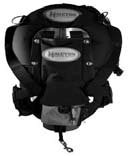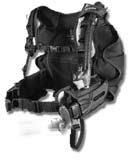Sleek BCDs from Mares and HalcyonContents of this Issue: All West Apartments and Diving, Curacao Thumbs Down: Sunset Divers, Curacao Wait Times for Flying After Diving Cheng Ho, Raja Ampat, Indonesia Tipping on Dive Trips: Part II What Happens If You Miss the Boat? Want to Sue That Dive Shop? Good Luck A Brief History of the Wetsuit Divers Saved After 40 Hours at Sea Sleek BCDs from Mares and Halcyon Editorial Office: Ben Davison Publisher and Editor Undercurrent 3020 Bridgeway, Suite 102 Sausalito, CA 94965 one is a clear winner for the traveling diver from the June, 2008 issue of Undercurrent
I like to dive with sleek equipment. I donít enjoy pushing bulky items through the water or carrying them through airports. Two simple wing-style BCDs look like they might qualify for minimal-style diving. The Italian-made Pegasus is a new lightweight BCD from Mares (www.mares.com) that employs a single-bag construction buoyancy cell and the Mares integrated-weight system. It employs a conventional harness and double crotch-straps, which I found superfluous when using a single tank. It has a broad waist strap that is supplemented by a sternum strap that was handy for tucking my corrugated hose neatly under. Hidden elastic straps restrain the wings. The whole effect is of a lightweight yet sturdy item.
The American-made Halcyon Eclipse (www.halcyon.net) has lots of shiny bits that seem attractive to younger divers. The buoyancy wing is of double-bag construction. The harness is a single continuous piece of webbing without breaks for buckles and it must be adjusted before entering the water. There are a heavyweight stainless- steel buckle and a broad webbing jockstrap. With Mares using modern technopolymers for fittings while Halcyon sticks with solid stainless-steel, the most obvious difference between the two is in terms of weight. With the Mares weighing a tad more than seven pounds, I doubt if you will see many divers checking in at any airport with the nearly 12- pound Eclipse unless they wear it! Efficiency and Comfort
The Pegasus integrated- weight system is quite capable of taking up to 14 pounds on each side without fear of losing anything. You can attach weight pouches to the waist strap of the Eclipse and add trim-weight pockets to the cambands (an extra cost option). While you can fit a specially shaped weight within the two parts of the stainless-steel single-tank adaptor, itís not something a traveling diver would find convenient. Both are equally comfortable. In the water, they worked just as they should, but from time to time I was left groping for the rather short and wayward hose of the direct-feed control of the Eclipse. The integrated-weight system of the Pegasus was sublime too, though I need 26 pounds in the Red Sea in mid-winter, whereas I had that weight on a separate belt with the Eclipse. Overall, I felt much neater in the water with the Pegasus. Control of Ascent The Pegasus offers three ways to dump air. You can pull on the hose to operate its top dump or you can tug at the toggle at the opposite shoulder to operate a valve that tends to be slightly more down the back than on top of the right shoulder. The other way is to lie slightly bottom-up and release air through the bottom dump, also located by its large toggle. Air tends to migrate to the top, which makes getting rid of it very efficient. The manufacturer of the Eclipse expects you to ascend while horizontal in the water and provides only the lower dump valve at the back, so you have to be circumspect about getting that last bit of air out, or else youíll need to dive over-weighted. Both wings leave the bottom dump valve facing downward unless you are horizontal but lying face up. Of course, you can always dump air with both of them through the corrugated hose and the oral inflation valve, but that does tend to fill the wing with water. Surface Support The Pegasus wins the battle when it comes to the maximum buoyancy available (45 pounds; it both expands as it inflates and is positioned low down in the water and therefore contributes more to lift). The Eclipse has a big doughnut-shaped buoyancy cell weighing 40 pounds; once you break the surface, a lot of it rises clear of the water and applies a down-force by the effect of its weight rather than an up-force because of the water it displaces. Wearing and Removal With the Pegasus, it was easy to unfasten the waist strap (not forgetting the double crotch straps too if you use them) and one shoulder strap so that I could swing it off the opposite shoulder. The Eclipse has a onepiece continuous webbing harness that is difficult to get out of while still in the water. Once Iíd undone the waist strap buckle and crotch strap, I needed to drop down under the water and somehow duck out of it. A bulky computer on the wrist could make it quite difficult, and I needed to use an excessive amount of adrenalin each time. When one takes into consideration both the difference in purchase price Ė the Eclipse is a whopping $695, while the Pegasus is $450. Add on the additional five pounds of checked-baggage allowance taken up by the Eclipse, and the Mares Pegasus becomes a clear winner for single-tank diving. John Bantin is the technical editor for DIVER magazine in the United Kingdom and a professional underwater photographer. |

I want to get all the stories! Tell me how I can become an Undercurrent Online Member and get online access to all the articles of Undercurrent as well as thousands of first hand reports on dive operations world-wide
| Home | Online Members Area | My Account |
Login
|
Join
|
| Travel Index |
Dive Resort & Liveaboard Reviews
|
Featured Reports
|
Recent
Issues
|
Back Issues
|
|
Dive Gear
Index
|
Health/Safety Index
|
Environment & Misc.
Index
|
Seasonal Planner
|
Blogs
|
Free Articles
|
Book Picks
|
News
|
|
Special Offers
|
RSS
|
FAQ
|
About Us
|
Contact Us
|
Links
|
3020 Bridgeway, Ste 102, Sausalito, Ca 94965
All rights reserved.



